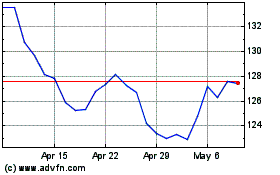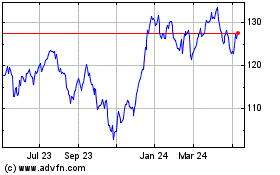Free Trade Critical to Modernizing Canadian and Alberta Economies-BMO
October 03 2012 - 1:30PM
Marketwired
The Canada-U.S. Free Trade Agreement (FTA), and the subsequent
North American Free Trade Agreement (NAFTA), have played a critical
role in the development of the Canadian and Alberta economies over
the last quarter century, according to a new report from BMO
Economics released on the 25th anniversary of the signing of the
FTA.
"Bottom Line, the FTA and NAFTA were critical in helping
modernize the Canadian economy and have ultimately played a big
role in transforming Canada from a relative underachiever among
industrial world economies to a relative overachiever," said Doug
Porter, Deputy Chief Economist, BMO Capital Markets.
"Of course, there have been a number of reforms Canada has taken
over the years, but in many respects the FTA paved the way," noted
Mr. Porter. "The deal sharply clarified trade and investment rules
within North America, and likely helped avert serious protectionist
measures from arising within the region during the steep economic
downturns of the past decade. There has been a net strengthening in
North American trade and foreign investment flows, and the deal
helped grease the slide for Canadian inflation."
The report notes that, while total bilateral trade with the U.S.
rose from just over 31 per cent of GDP prior to the FTA to a peak
of 56.7 per cent in 2000, the level has since receded to just over
36 per cent. "This retreat in trade doesn't mean the FTA hasn't
been a success," stated Mr. Porter. "The split personality of
Canadian exports to the U.S. in the past quarter century says as
much about the wild swings in the Canadian dollar and the
significant adjustments in the U.S. economy as they do about the
underlying strength of trade. Measured in U.S. dollar terms, export
progress appears much steadier over the first 20 years of the
agreement."
"Total trade between Alberta and the United States has risen at
an annualized rate of 9.2 per cent a year since 1990," said Bill
Hogg, Vice President, Commercial Banking, BMO Bank of Montreal.
"Free trade has clearly been an important boon for the Alberta
economy and has helped make the province one of the strongest
economic engines in Canada."
Beyond increasing trade, the FTA and NAFTA also aimed to
strengthen and improve the environment for cross-border investment,
especially foreign direct investment. "Overall, the FTA should be
judged a success on this front. Foreign direct investment from the
U.S. into Canada averaged just $1.7 billion annually in the six
years prior to the FTA, and $4.7 billion per year in the first six
years of the FTA, but then has shot up to $19.8 billion per year
since 1995," said Mr. Porter. "As a share of GDP, those figures are
0.3 per cent, 0.7 per cent and then all the way up to 1.6 per cent.
A little more than half of the inflows since 1995 have been in the
resource and financial services sectors."
Provincial Trade Value With United States (1990-2011) % chng a.r.
----------------------------------------------------------------------------
Canada 5.0
----------------------------------------------------------------------------
Saskatchewan 9.8
----------------------------------------------------------------------------
Alberta 9.2
----------------------------------------------------------------------------
Newfoundland and Labrador 8.6
----------------------------------------------------------------------------
New Brunswick 8.0
----------------------------------------------------------------------------
Prince Edward Island 7.5
----------------------------------------------------------------------------
Manitoba 7.1
----------------------------------------------------------------------------
Ontario 4.1
----------------------------------------------------------------------------
British Columbia 4.0
----------------------------------------------------------------------------
Quebec 3.3
----------------------------------------------------------------------------
Nova Scotia 2.9
----------------------------------------------------------------------------
The full report can be downloaded at
www.bmocm.com/economics.
Contacts: Media Contacts: Peter Scott (416)
867-3996PeterE.Scott@bmo.com Ronald Monet (514)
877-1873ronald.monet@bmo.com Laurie Grant (604)
665-7596laurie.grant@bmo.com Internet: www.bmo.com Twitter:
@BMOmedia
Bank of Montreal (TSX:BMO)
Historical Stock Chart
From Mar 2024 to Apr 2024

Bank of Montreal (TSX:BMO)
Historical Stock Chart
From Apr 2023 to Apr 2024
